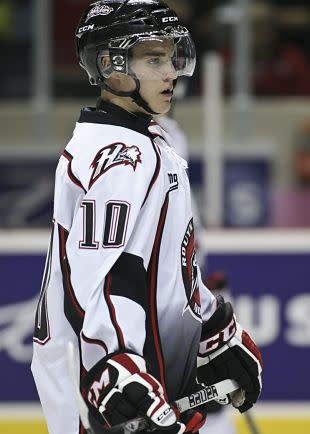Reasonable expectations: The curse of the hot start
It's unfortunate that there isn't a way to contextualize what certain goal scorers have accomplished in the Ontario and Western Hockey Leagues. Those leagues don't release individual shot data, which makes it particularly tough to judge player performance, particularly in the early part of the season.
A good example of what we can do with simple shot numbers, like the ones the Québec League offers, is be able to tell when a scoring streak is percentages or performance-induced. The somewhat controversial idea among a few National Hockey League analysts (including myself) is that goal-scoring itself is not the repeatable talent possessed by hockey players—rather, getting pucks to the net and shooting lots, is what separates sheep from the flock.
Upon first glance, the Rouyn-Noranda Huskies' Jean-Sébastien Dea is having a killer season in the QMJHL. At 15 goals in 11 games, you could say he's on pace for 93 goals over a 68-game season. The problem is that his brief uptick in scoring hasn't been performance-induced. It's situation, and he's gotten some excellent luck along the way.
Which should be obvious enough, right? In his draft year, Dea scored 17 goals. The transition from an above-average QMJHL scorer to Mario Lemieux doesn't happen one summer. A lot of his goal-scoring has come thanks to the fact that he has an unbelievable 46.9% shooting rate, scoring 15 goals off of his 32 shots.
The best forwards in the "Q", such as Nathan MacKinnon or Phillip Danault, will have higher than average shot rates, but those will be backed up by high shot numbers. MacKinnon has taken five shots on average per game at the net, so even with a more reasonable 20% shot rate, he still has high scoring totals. No so for Dea, who is playing with an unsustainable shooting percentage that isn't very likely to last:
Player | Goals | Sh% |
|---|---|---|
Jean-Sebastien Dea | 15 | 46.9% |
Nathan MacKinnon | 12 | 23.1% |
Josh Currie | 11 | 21.2% |
Phillip Danault | 11 | 20.8% |
Dmitri Jaskin | 10 | 16.1% |
Luca Ciampini | 9 | 37.5% |
Mikhail Grigorenko | 9 | 27.3% |
Sven Andrighetto | 9 | 16.4% |
Jonathan Huberdeau | 9 | 20.0% |
Charles Hudon | 9 | 18.4% |
His shots may be good, but he's been helped out by powerplay scoring, by poor goaltender performances, and by getting the right amount of puck-luck. If he were scoring at last season's shot rate, he'd have 7-8 goals at this point, not 15.
Prediction for the rest of the season? Based on his 2.91 shots per game this season, and a normalized shooting percentage, Dea scores 40 goals over the next 57 games. Combined with his outburst at the beginning of this campaign that gives him a very strong 55-goal season, probably makes him a shoe-in to be drafted as an 18-year old.
Let's look at the OHL player of the week, Dylan Smoskowitz. I'd see a couple bits of analyses from scouts who suggested that Smoskowitz was rejuvenated at home after being traded to the Mississauga Steelheads. He has seven goals in five games—more recently, four in his last two outings—after lighting the lamp just 24 times in 127 career OHL games.
Without shooting percentages, it's harder to play "spot the outlier season." Now, we do know that scorers become more prominent the older they get, but the way Smoskowitz and Dea have lit the lamp at times this year, it's almost as if they aged three years overnight.
For context, and how Smoskowitz's numbers this season probably aren't predictive of his future, we can see that back in February 2011, he scored seven goals in three games with the Barrie Colts, capped off by a four-goal outing against Kingston.
Smoskowitz would go goal-less for his next seven games, and score just one in his next 18. The point here is don't expect hot streaks to continue, since they aren't an accurate reflection of player talent.
It's happening out West, too. 1993-born J.C. Lipon has 11 goals and 27 points in 11 games, putting him on a pace that dwarfs his career highs. As fun as "Liptober" has been in Kamloops for the still-unbeaten-in-regulation Blazers, I think it highly unlikely that Lipon beats his career high in goals by 53 this season.
Again, with individual shot statistics, like those offered in the QMJHL, we could provide reasonable expectations for not only where Dylan Smoskowitz and J.C. Lipon end up, but also the remainder of the cast of players in the OHL and the WHL who have higher-than-expected goal and point totals to start the season.

 Yahoo Sports
Yahoo Sports 


